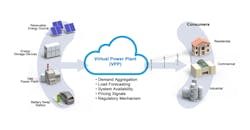With the maturation of renewable-energy harvesting technologies, green energy is gradually becoming a viable alternative to conventional, environment-unfriendly power sources. For all its benefits, this new reliance on green energy puts stress on grid stability.
Since grids rely heavily on balancing power supply and demand, the unpredictability of green energy brings about several challenges. Technology that allows a grid to respond quickly to power fluctuations is crucial to ensure a more resilient grid. This is where the Virtual Power Plant (VPP) enters the picture.
VPPs crowdsource energy from a variety of resources. Ranging from renewable energy power plants, rooftop solar panels, energy storage batteries, to electric vehicles, VPPs harvest energy from anywhere and anyone. Harvesting and dispatching power successfully from both conventional and unconventional sources requires live monitoring.
As an example, imagine a world where electric vehicles are the main source of commuting. During power demand peaks, VPPs could prompt connected vehicles at charging centers to divert power back to the grid to solve urgent needs. Inversely, if an excess of renewable energy is produced, the power can be stored in the vehicles.
By matching supply with demand, VPPs also play a crucial part in reducing wasted energy. The most common instance of energy waste is discarding excess renewable energy generated for a local area. In a VPP setting, this can be avoided. Let's say the supply of wind-powered energy exceeds the demand of the grid for a particular area. In this case, power usage can be stimulated by reducing the price through the time-price mechanism, solving the problem.
VPPs may hold the key to our future energy needs. Even so, before VPPs can become a full-fledged reality, a few kinks need to be ironed out. To achieve grid resilience, for instance, a VPP must be able to answer questions such as: "How much renewable energy will be integrated into the grid?", "How much energy would the user need?", or "How many electric vehicles are currently charging?". This is not as simple as installing an API on your smartphone.
To receive data, field devices may have to be installed next to a desert's solar power plant subject to extreme heat, or adjacent to an oceanside wind turbine facing corrosive salty winds, or even installed within a substation itself with high, signal-confusing, electromagnetic waves. Also, collecting the data requires a professional workforce to integrate various industrial designs and protocols—a difficult task.
The solution is the IIoT. Let’s take a closer look at how IIoT technology can help VPPs build a strong, everlasting data stream foundation.
Demystifying Power Distribution Networks
To help distribution system operators (DSO) get the most out of a power grid, real-time knowledge of load changes is critical. As a German DSO recently found out, this can be a monumental task.
Two years ago, the German DSO was unable to see electricity consumption data for one of its low-voltage grids. The DSO turned to IIoT technology to achieve more transparency regarding the substation’s power data. The goal was to turn 21 categories of measured data—such as voltage, current, frequency, and active/reactive power—collected from the feeders every minute into information that operators could easily view and understand. Such information can maximize the existing power distribution system’s ability to deliver more power to the 2.3 million households it serves.
Trouble was that the feeders from substations not only vary in quantity but also come in different shapes and sizes while also being dispersed in several locations. On top of that, to prevent the installers from accidentally touching other equipment during routine entries and exits, substations are strictly controlled. This posed two new challenges: First, how to quickly install IIoT technology with less labor? Second, how to efficiently patch these IIoT devices in different substations to ensure safety?
In this case, the system integrator proposed an end-to-end solution that could quickly and securely deploy IIoT devices without changing the design of the substation. This system allowed settings to be stored and managed remotely on a cloud device management platform. Settings can also be automatically imported into a field device after passing the security certifications, eliminating the need for tedious activation steps. In addition to resolving the issue with personnel expertise and resource scheduling, this solution makes remote patches available. This powerful system design accelerates the speed of grid upgrades and helps promote the “Internet of Energy.”
The Power to Dispatch: Real-Time Control
Historically, renewable energy generation was regarded as unstable and unpredictable. For it to be sustainable, supply and demand need to be balanced. To achieve an optimal supply-demand balance, under certain national grid codes, renewable power plants need to complete the adjustment of grid-connected power within 150 milliseconds. Since this window of exchange is so small, stable and reliable real-time data collection is imperative.
Stable data transmission is arduous due to the data-hosting equipment often being distributed in vast, mainly outdoors, terminal sites where severe weather, salt erosion or electromagnetic interferences are the norm. To prevent data loss and ensure the smooth transmission of data in real time, high-end network redundancy technology is in place. When one network is unavailable, data can be transmitted via the backup, ensuring an uninterrupted data stream, and creating a precise, 24-hour nonstop, real-time monitoring and control system.
A Win-Win for Users and Operators
Data can also be found in the advanced metering infrastructure (AMI) that goes deep into homes and buildings. AMI makes electricity usage information fully transparent. Consumers can track their own electricity consumption down to the second through their cellphones, while grid operators can shorten repair time by using AMI to find abnormalities in real time without waiting for user notifications.
After obtaining real-time user data, the "waveform" distribution of each household's electricity consumption can be calculated to better understand or even predict the consumption during each timespan. This information helps users avoid waste by turning off the air conditioner in a vacant space or even helping providers match prices for specific time slots. Achieving this requires electricity consumption data to be accurately returned to the operator's system.
While household meters are not installed in environments as harsh as their outdoor counterparts, the layout of each deployment field is usually complex and diverse with the complications of human influence. Any tiny bit of carelessness could potentially affect the stability of communication. Operators could receive the wrong electricity usage information and miscalculate the electricity consumption.
To avoid information loss, a store-and-forward technology is used when communication is down. The meter data can be stored first and sent out after the communication is restored to protect the rights of both users and operators.
Trading Virtual Power
When information becomes more transparent and the prices of renewable energy technologies become more affordable, users can also become producers, in other words, selling electricity to the grid. This shift makes supply-demand scheduling even more flexible.
Achieving this level of flexibility involves a secure and decentralized network. For some operators, the answer is the combining of virtual power plants with blockchain. Through blockchain’s smart transaction contract, safe and smooth purchases and the transfer of energy can be ensured due to blockchain’s decentralized, transparent, and tamper-proof nature. This design gives consumers the freedom to choose from cheaper, sometimes unconventional sources, such as their neighbors, and skip the middle aggregators.
Through IIoT technologies, power grids are being transformed from experience-based management to data-driven management. Multiple platforms, combined with the participation of the general population, will make the grid more powerful with power utilization rates increasing, power waste being reduced, and a world with high energy efficiency can truly be realized.












